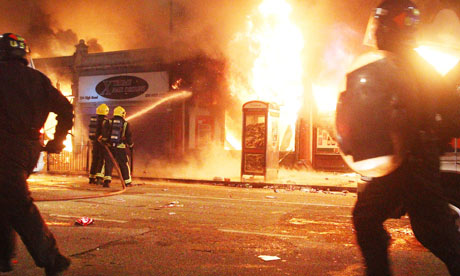The maker of the BlackBerry, Research in Motion, said on Monday night that it would co-operate with a police investigation into claims that its popular BlackBerry Messenger service played a key role in organising the London riots.
Scotland Yard vowed to track down and arrest protesters who posted "really inflammatory, inaccurate" messages on the service, and the social networking websites Twitter and Facebook.
Patrick Spence, the managing director regional marketing at Research In Motion (RIM), confirmed that the BlackBerry manufacturer had contacted police to assist with the investigation.
However, the statement prompted fears from some BlackBerry users that their private messages could be handed over to the police.
"We feel for those impacted by the riots in London. We have engaged with the authorities to assist in any way we can," Spence said. He added that RIM complies with UK legislation on the interception of communication and co-operates fully with the Home Office.
RIM refused to comment further or answer a series of questions on the statement.
BlackBerry Messenger (BBM) appears to be the favoured method of planning the unrest that has swept across north London since Saturday evening. Unlike text messaging or Twitter, BBM is a free, private social network where almost all messages are encrypted when they leave the sender's phone – meaning that many messages are untraceable by the authorities.
RIM can be legally ordered to hand over details to police of users suspected of unlawful activity. However, the Canadian company would be likely to resist those demands and the content of users' inflammatory messages would be encrypted. The manufacturer has previously insisted that even it cannot unscramble users' messages when sent on the devices.
Although Twitter and Facebook have played a key role in past unrest in the capital, the Tottenham riots are thought to be the first in the UK so heavily orchestrated using BlackBerry Messenger.
The "broadcasts" – which are sent instantly from one-to-many BBM users – have been reposted and amplified on Twitter and Facebook. Evidence of rioters planning where to hit next spread quickly on the networks as the police struggled to keep up.
One BBM broadcast posted on Monday evening appeared to urge protesters to go looting in Stratford, east London. "If you're down for making money, we're about to go hard in east london tonight, yes tonight!!" it said. "I don't care what ends you're from, we're personally inviting you to come and get it in. Police have taken the piss for too long and to be honest I don't know why its taken so long for us make this happen. We need a minimum of 200 hungry people. We're not broke, but who says no to free stuff. Doesn't matter if the police arrive cos we'll just chase dem out because as you've seen on the news, they are NOT ON DIS TING. Everyone meet at 7 at stratford park and let's get rich."
Another broadcast implored protesters to "unite and hit the streets" in Kilburn, north-west London. On Sunday BBM users were urged to head to Oxford Circus for "pure terror and havoc & free stuff".
Steve Kavanagh, the deputy assistant commissioner of the Metropolitan police, said that "really inflamatory, inaccurate" messages on Twitter were mainly to blame for the disorder. "Social media and other methods have been used to organise these levels of greed and criminality," he said at a press conference on Monday afternoon.
Asked whether those behind the messages could be arrested, Kavanagh said: "Absolutely." He added: "That investigation is already under way and that is exactly the sort of thing we are looking at."
The main Facebook page set up in memory of Mark Duggan, the Tottenham resident whose death last week triggered the weekend riots, on Monday sought to distance itself from the violence.
The tribute page, which had close to 10,000 fans at the time of writing, on Saturday called for users to share videos and pictures of the torched double decker bus and police cars "to send the message out as to why this has blown into a riot".
On Monday the page struck a more conciliatory tone as unrest spread further across the capital. "If people cared about this 'Tribute' page, they will stop burning & looting. Those who encourage it, well you need to grow up. Mark's family do not need this!" those behind the page posted.

BlackBerry has promised to help police investigate claims its Messenger service helped fuel and organise riots and looting in Tottenham, north London. Photograph: Lewis Whyld/PA



